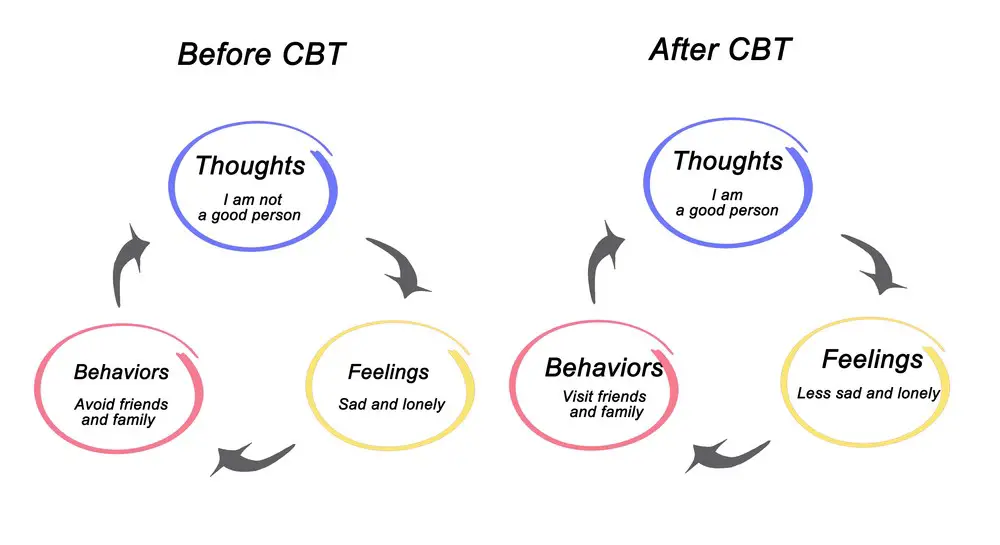Psychodynamic therapy and cognitive behavioral therapy (CBT) are two prominent approaches mental health professionals utilize to address various mental health issues. Both therapeutic models have been widely researched and supported, yet each offers a distinct perspective on the origin of psychological problems and the appropriate methods for addressing them. It is essential to delve into their underlying theories and techniques to understand better and compare these treatment modalities.
Psychodynamic therapy traces its roots back to the work of Sigmund Freud and focuses on the unconscious mind’s role in shaping an individual’s thoughts, feelings, and behaviors. By examining past experiences, unresolved conflicts, and unconscious desires, psychodynamic therapy seeks to unveil hidden patterns contributing to present-day struggles. This approach aims to foster heightened self-awareness, emotional growth, and improved interpersonal relationships.
On the other hand, cognitive behavioral therapy (CBT) was developed as a more structured, present-focused, and goal-oriented approach, emphasizing the role of thought patterns and maladaptive behaviors in perpetuating psychological distress. CBT has been recognized as an effective, evidence-based treatment for various mental health concerns by identifying and challenging unhelpful thinking and developing healthier behavioral habits.
Psychodynamic Therapy and CBT Overview

History and Founders
Psychodynamic therapy originated from the psychoanalytic theories of Sigmund Freud. Psychoanalysis, a major foundational element in modern psychodynamic therapy, emerged in the late 1800s. Freud’s work emphasized the importance of the unconscious mind and intrapsychic conflicts in shaping human behavior.
Cognitive-behavioral therapy (CBT) has its roots in two distinct yet overlapping fields: cognitive therapy, founded by Aaron Beck in the 1960s, and Rational Emotive Behavior Therapy (REBT), developed by Albert Ellis in the 1950s. Today, CBT is a widely used evidence-based approach to address various psychological disorders.
Key Principles
Psychodynamic Therapy
- Focuses on the unconscious mind and its impact on thoughts, feelings, and behavior
- Places significant importance on early childhood experiences and attachment relationships
- Views intrapsychic conflicts, such as conflicting desires or needs, as central to psychological distress
- Aims to help clients gain insight into their unconscious motivations and their origins and use this understanding to resolve issues
Cognitive-Behavioral Therapy
- Emphasizes the role of thoughts, or cognitions, in shaping emotions and behavior
- Focuses on identifying and changing maladaptive thought patterns and behaviors
- Uses a structured, goal-oriented approach to therapy sessions, often with specific, measurable objectives
- Incorporates a variety of techniques, such as cognitive restructuring, behavioral experiments, and exposure exercises
Methods and Techniques
Psychodynamic Therapy Methods
Psychodynamic therapy is a form of psychotherapy that explores the role of unconscious processes and unresolved past experiences in shaping an individual’s behavior, thoughts, and emotions. The therapist encourages clients to discuss their inner experiences, including dreams, fantasies, and early memories. Some commonly used techniques in this approach are:
- Free association: The client is encouraged to share thoughts, feelings, and associations without censoring them. This allows the therapist to uncover unconscious patterns and conflicts.
- Transference: The client may start to project feelings or expectations from past relationships onto the therapist, providing insights into unresolved issues and emotional challenges.
- Dream analysis: The therapist helps the client explore the meaning of their dreams to uncover unconscious emotions and thoughts.
- Working through: The process of addressing and resolving unconscious conflicts and past experiences by working through them in the therapeutic setting.
CBT Methods

Cognitive Behavioral Therapy (CBT) is a solution-focused and action-oriented approach to psychotherapy, aiming to help clients identify and change dysfunctional thought patterns and behaviors contributing to emotional distress. Some common methods and techniques used in CBT include:
- Cognitive restructuring: The therapist helps the client identify and challenge irrational or maladaptive thoughts and replace them with more adaptive ones.
- Behavioral experiments: The client tests the validity of their beliefs and assumptions by undertaking activities that could help them gather evidence supporting or refuting such notions.
- Exposure therapy: The client confronts feared situations or stimuli in a controlled environment, leading to a reduction in anxiety through habituation.
- Skills training: The therapist teaches clients specific coping strategies and techniques, such as relaxation exercises, problem-solving, or communication skills, to improve their daily functioning.
While psychodynamic therapy and CBT are talking therapy approaches, they differ in focus and techniques. Other therapy approaches include client-centered therapy, which emphasizes the importance of the therapist-client relationship and the client’s capacity for self-discovery, and Gestalt therapy, which centers on enhancing self-awareness and integrating unresolved feelings. Each therapy approach employs unique methods and techniques, catering to different client needs and preferences.
Effectiveness and Treatment Duration
Long-Term Treatment
Psychodynamic therapy is a long-term treatment option that focuses on exploring the unconscious mind, which can improve mental health and quality of life. It effectively reduces symptoms and improves overall psychological functioning in several randomized controlled trials. Due to its lengthy nature, psychodynamic therapy might be more suitable for individuals with chronic or complex conditions.
Cognitive Behavioral Therapy (CBT) is usually offered as a time-limited approach, typically between 12 and 20 sessions. Despite its shorter duration, it has been proven to be an efficacious intervention for various mental health issues. Numerous randomized controlled trials support the effectiveness of CBT in reducing symptoms and improving the quality of life for patients.
Short-Term Treatment
For those seeking a more short-term treatment option, CBT offers a time-limited approach that concentrates on identifying and modifying negative thought patterns and behaviors. The focus on symptom reduction can lead to noticeable improvements in mental health within a short period. This makes CBT attractive for individuals with less severe conditions or those looking for rapid results.
On the other hand, short-term psychodynamic therapy, known as brief psychodynamic therapy, is a condensed version of traditional psychodynamic therapy conducted within a limited time frame (usually under 20 sessions). It addresses specific issues related to the patient’s current life situation. While its efficacy has been debated, some studies have found it effective for certain mental health conditions and improving quality of life.
In conclusion, both psychodynamic therapy and CBT offer different approaches and timeframes for treatment. The choice depends on the individual’s specific needs, preferences, and goals in therapy.
Mental Health Conditions Addressed
Anxiety and Mood Disorders
Psychodynamic and cognitive-behavioral therapy (CBT) are effective approaches for treating mental health conditions like anxiety and depression. In psychodynamic therapy, individuals explore their unconscious thoughts and feelings, often drawn from past experiences, to better understand how these emotions impact their current relationships and behaviors. On the other hand, CBT focuses on identifying and changing patterns of negative thoughts and behaviors that contribute to anxiety and mood disorders.
Personality and Eating Disorders
Personality disorders and eating disorders are complex mental health conditions that both psychodynamic therapy and CBT can also address. Psychodynamic therapy can help individuals with personality disorders uncover unconscious motives, emotions, and conflicts which may be contributing to their condition. This approach can also be beneficial in treating eating disorders by exploring the emotional and interpersonal factors that influence an individual’s relationship with food.
CBT can also be an effective treatment for personality and eating disorders. Individuals learn to manage their emotions, thoughts, and behaviors by developing coping strategies. Moreover, CBT can help people with eating disorders address distorted thoughts about weight and body image, resulting in more adaptive and healthy behaviors.
PTSD and Trauma
Post-traumatic stress disorder (PTSD) and trauma-related conditions can be treated using both psychodynamic therapy and CBT. In psychodynamic therapy, individuals with PTSD may work through unresolved feelings, emotions, and memories tied to their traumatic experiences. By processing these emotions, individuals can better understand their past experiences’ impact on their current functioning, ultimately leading to improved mental health.
CBT, particularly a specialized form called trauma-focused CBT, is also effective in addressing PTSD. Through this approach, individuals learn to identify and challenge intrusive thoughts related to their trauma and develop coping mechanisms to manage their symptoms.
Key Differences between Psychodynamic Therapy and CBT
Focus on Past vs Present
Psychodynamic therapy primarily focuses on an individual’s past experiences, childhood events, and subconscious mind to uncover the root cause of their present issues. The therapist helps patients understand how unconscious conflicts influence their behavior and emotions.
On the other hand, cognitive behavioral therapy (CBT) concentrates on the present moment. The therapist and patient collaborate to identify and modify unhelpful thoughts, beliefs, and behaviors to address current problems. CBT is goal-oriented and focused on helping clients develop coping skills and problem-solving strategies.
Role of Therapist
In psychodynamic therapy, the therapist often takes a more passive role by listening and interpreting the patient’s experiences. They provide a safe environment for clients to explore their feelings and emotions related to past experiences. The therapist’s interventions help patients recognize their unconscious motivations and promote self-understanding.
In CBT, the therapist adopts a more active, directive role. They work closely with the patient to identify goals and develop a treatment plan. The therapist uses various techniques to assist clients in changing their thought patterns and behaviors, such as Socratic questioning and behavioral experiments. The CBT therapist also provides homework assignments for clients to practice the skills they have learned during therapy sessions.
Therapeutic Techniques
Psychodynamic therapy employs various techniques to facilitate self-exploration and understanding, such as:
- Free association: Patients express thoughts and feelings without inhibition.
- Dream analysis: The therapist helps interpret dreams to reveal unconscious desires and conflicts.
- Transference: The patient’s feelings towards the therapist can help uncover unresolved past issues.
CBT utilizes a range of techniques to help clients modify thoughts and behaviors, including:
- Cognitive restructuring: Identifying and challenging negative thoughts.
- Behavioral activation: Encouraging clients to engage in activities that boost mood.
- Exposure therapy: Gradually facing and overcoming fears.
While psychodynamic therapy and CBT can be effective for various psychological issues, their approaches and emphases differ significantly.
The Role of Emotions and Thoughts
Expression and Repression
In psychodynamic therapy, emotions are central to determining a person’s behavior. The therapist helps individuals work through repressed emotions, such as anger, that may contribute to their problems. They might use free association and dream analysis techniques to uncover these unconscious emotions.
In contrast, Cognitive Behavioral Therapy (CBT) focuses more on a person’s thoughts and beliefs in shaping their behavior. The premise behind CBT is that thought patterns contribute to maladaptive behavior. For example, negative thought patterns can lead to anxiety or depression, and a CBT therapist helps patients identify and change these patterns.
Cognitive Patterns and Beliefs
Psychodynamic therapy and CBT address cognitive patterns and beliefs, but they do so differently. In psychodynamic therapy, it is assumed that a person’s beliefs stem from their unconscious mind and are influenced by their past experiences or defense mechanisms. Thus, the goal is to bring these unconscious beliefs to conscious awareness and work through them to achieve positive change.
CBT focuses on a person’s conscious thought patterns and how their beliefs affect their emotions and behavior. The therapist helps individuals identify distorted or unhelpful thoughts (such as catastrophizing or assuming the worst) and learn techniques to challenge and modify these thoughts. This, in turn, leads to changes in emotion and behavior.
Overall, psychodynamic therapy and CBT recognize the importance of the emotional and cognitive aspects of a person’s mental health. The key distinction is that psychodynamic therapy delves deeper into the unconscious mind and the repression of emotions, while CBT emphasizes the conscious, cognitive patterns that guide and shape a person’s behavior.
Adapting to Different Populations
Children and Adolescents
Psychodynamic and cognitive behavioral therapy (CBT) can be adapted for different populations, such as children and adolescents. In treating younger populations, age-appropriate techniques and language are essential. For instance, psychodynamic therapy may involve play or art therapy to foster self-expression and insight into interpersonal functioning. In contrast, CBT for children incorporates cognitive and behavioral strategies such as journaling, role-play, or practicing effective communication skills.
Adults
Psychodynamic therapy and CBT can address a wide range of mental health concerns for adults. Psychodynamic therapy explores unconscious motivations, emotions, and relational patterns in adults’ lives. It often utilizes techniques like free association and dream analysis to uncover these underlying patterns. In comparison, CBT focuses on changing maladaptive thought patterns and behaviors in adults through techniques like cognitive restructuring, exposure therapy, and behavioral activation.
Relationships
Psychodynamic therapy and CBT can be applied to couples therapy in relationships. Psychodynamic couples therapy addresses interpersonal functioning by identifying unconscious patterns and internal conflicts contributing to relationship issues. On the other hand, CBT-based couples therapy focuses on helping partners identify and modify problematic thoughts and behaviors, fostering healthier communication and problem-solving skills.
- Psychodynamic therapy:
- Children and adolescents: play therapy, art therapy
- Adults: free association, dream analysis
- Relationships: addressing unconscious patterns, internal conflicts
- CBT:
- Children and adolescents: journaling, role-play, communication skills
- Adults: cognitive restructuring, exposure therapy, behavioral activation
- Relationships: modifying thoughts and behaviors, healthy communication, problem-solving skills
Combining Approaches and Alternatives
Integrative and Interpersonal Therapy
Integrative therapy combines elements of different therapeutic approaches, such as psychodynamic therapy and cognitive-behavioral therapy (CBT). This customized approach allows therapists to tailor treatment to each client’s unique needs, preferences, and goals.
Interpersonal therapy (IPT) is a specific type of integrative therapy that focuses on the relationships between the individual and others. IPT often involves identifying and addressing interpersonal issues or communication patterns contributing to psychological distress. Clients can improve their mental health and overall well-being by improving interpersonal skills. Media, like books and videos, can be used to support this process.
Humanistic and Dialectical Behaviour Therapy
Humanistic therapy helps individuals discover their innate potential for personal growth and self-actualization. This approach emphasizes the importance of empathy, self-awareness, and self-exploration, allowing clients to understand themselves better and create meaningful, authentic connections with others.
Dialectical behavior therapy (DBT) is a cognitive-behavioral therapy that helps individuals build skills to manage emotions, deal with stressful situations, and improve relationships. DBT typically incorporates group therapy, teaching clients the practical skills they need to navigate challenges, and individual therapy, helping clients apply those skills to their unique situations.
Incorporating different therapeutic approaches and treatments can help clients achieve the best possible outcomes for their mental health. Both humanistic and dialectical behavior therapies focus on improving interpersonal relationships, and they can complement psychodynamic therapy and CBT in addressing various mental health concerns.
FAQs
- The Burnout Epidemic: Why We’re All Feeling Overwhelmed and How to Cope - February 9, 2024
- How to Live a Peaceful Life - February 9, 2024
- Useful Information You Should Know About Health Screenings - February 8, 2024
This site contains affiliate links to products. We will receive a commission for purchases made through these links.



